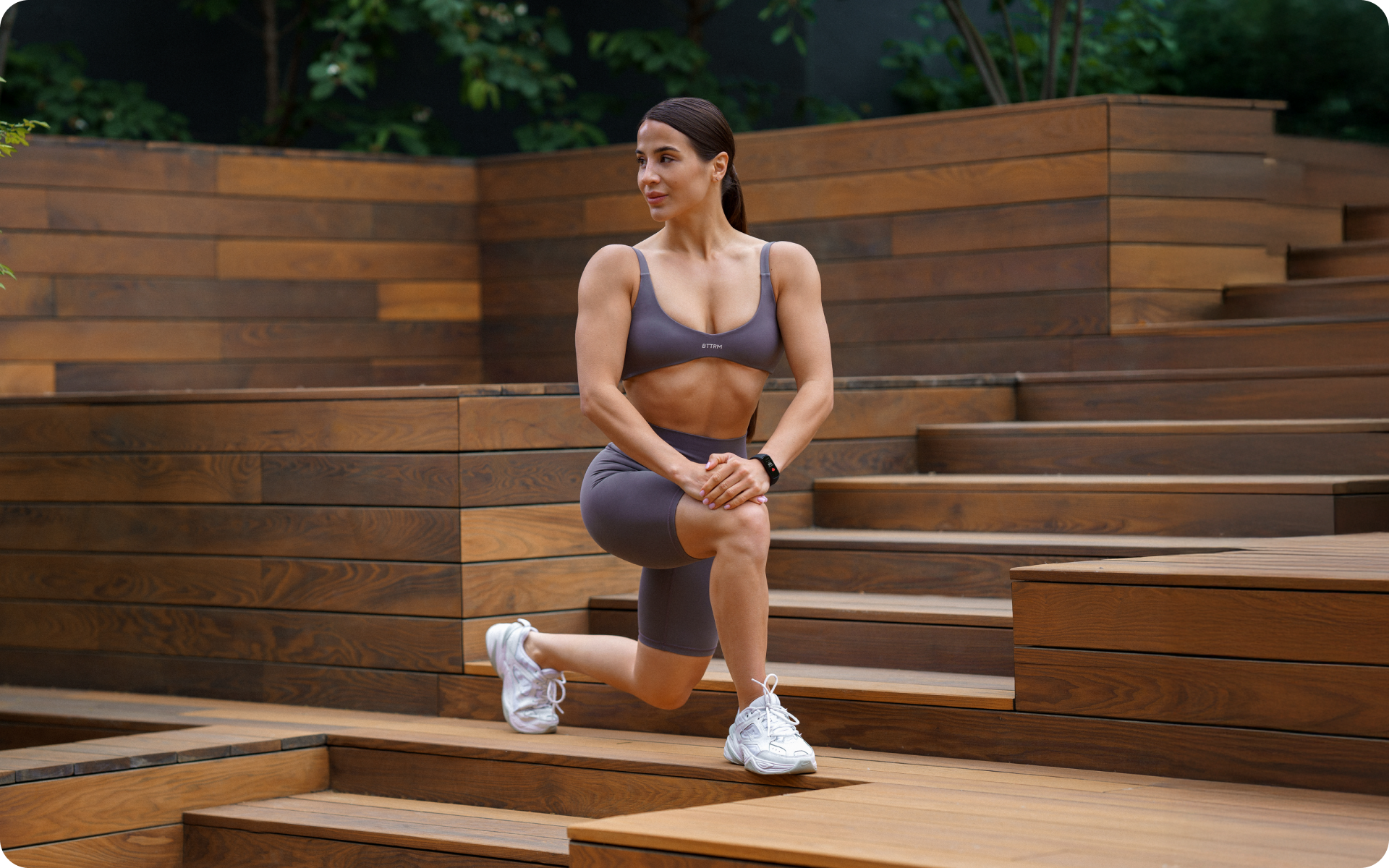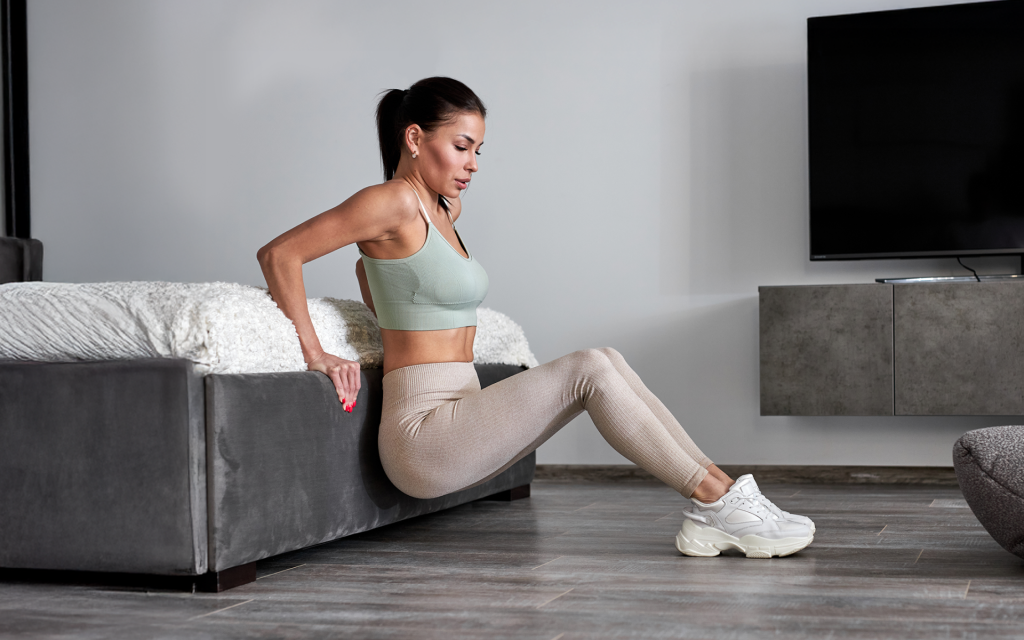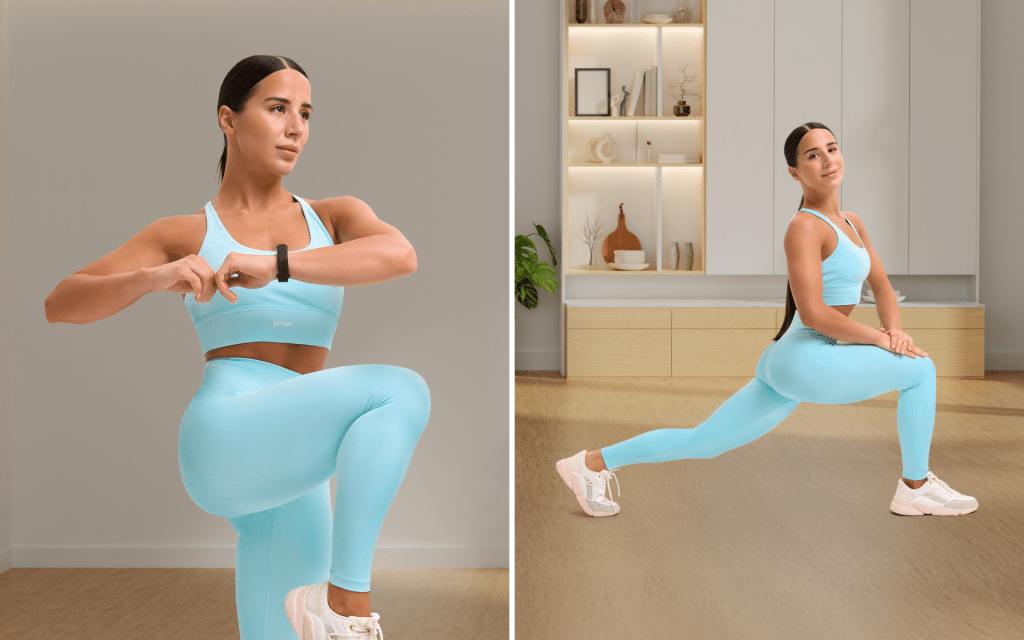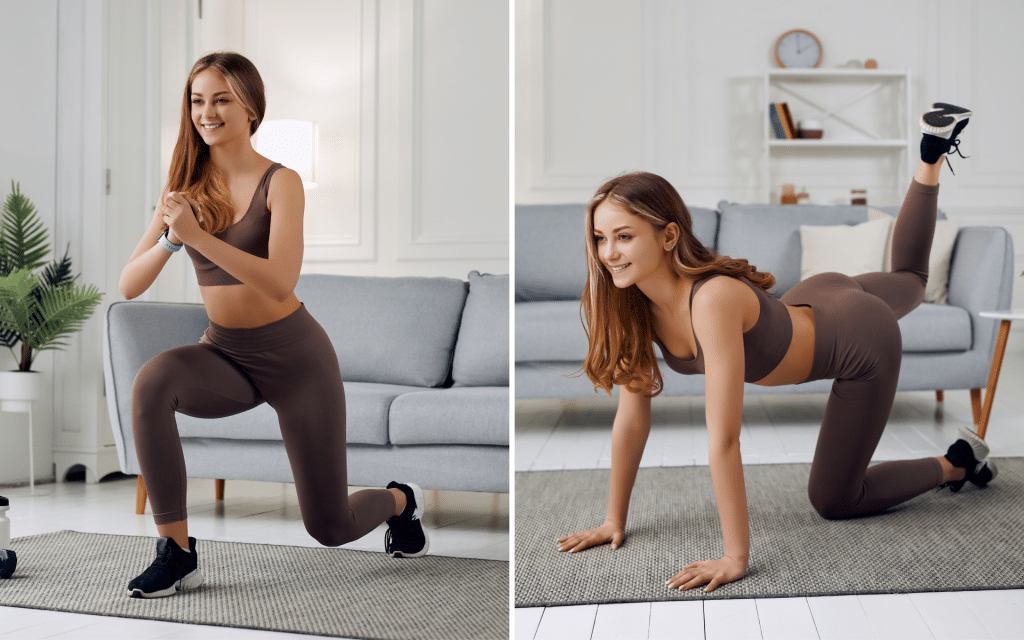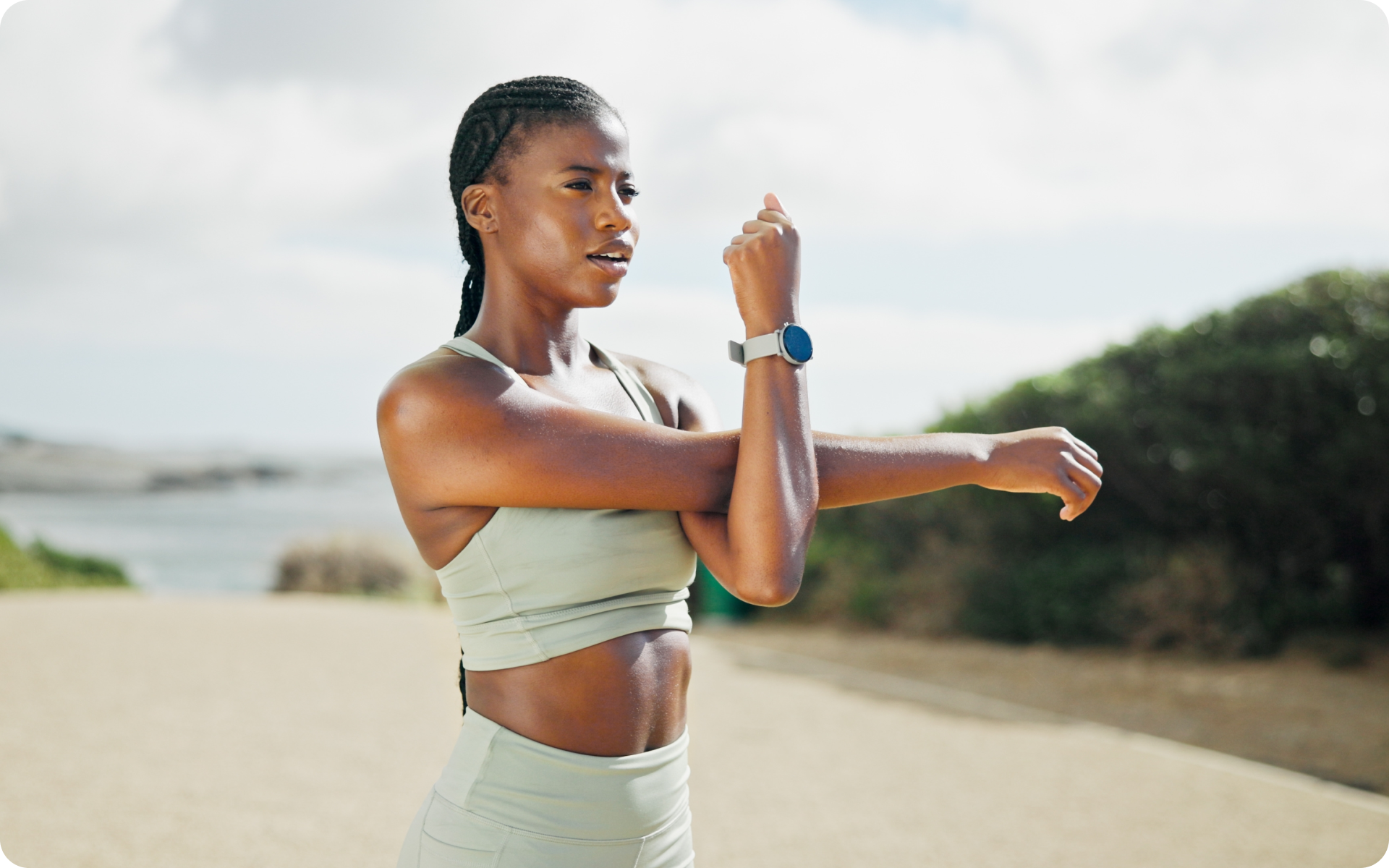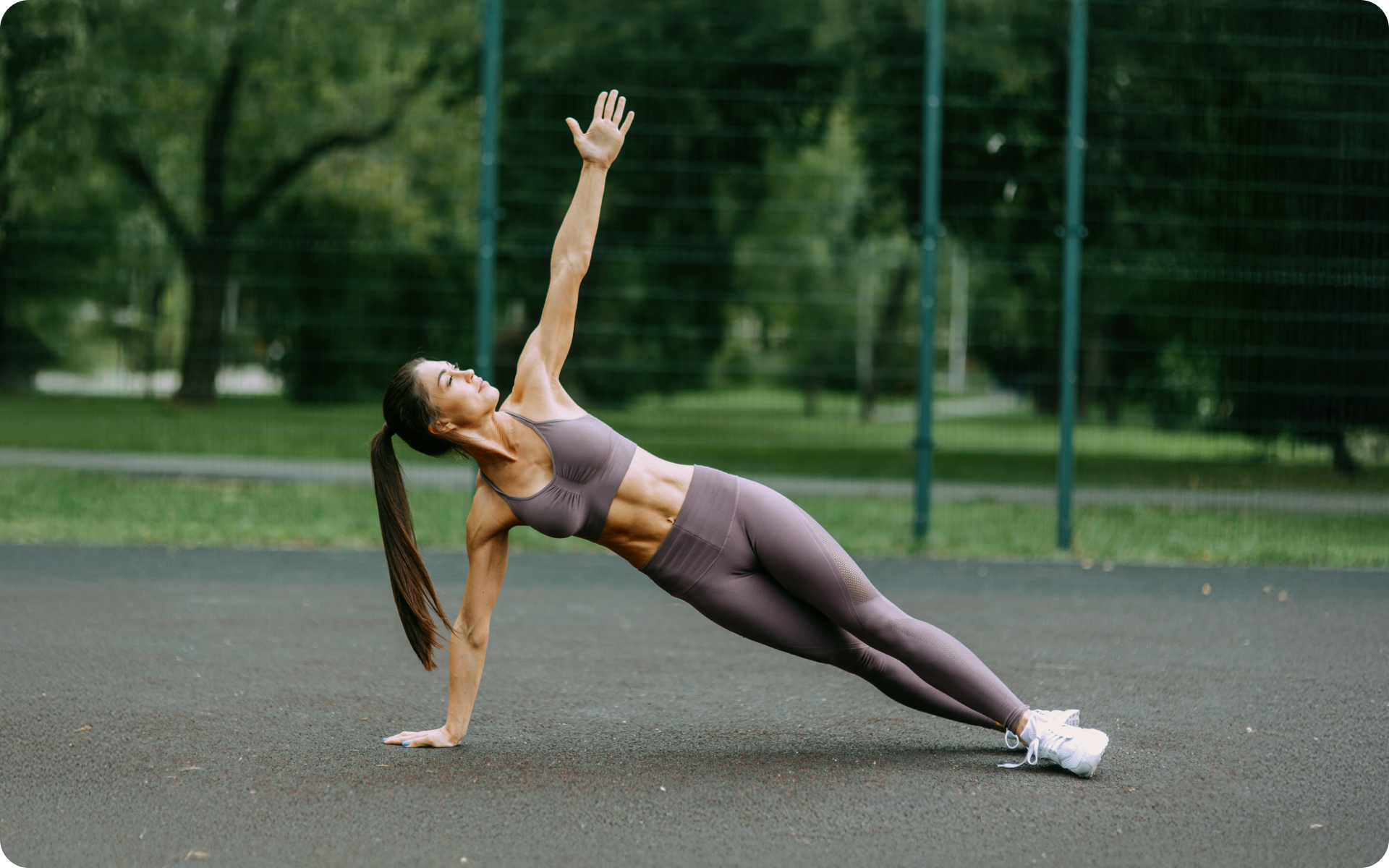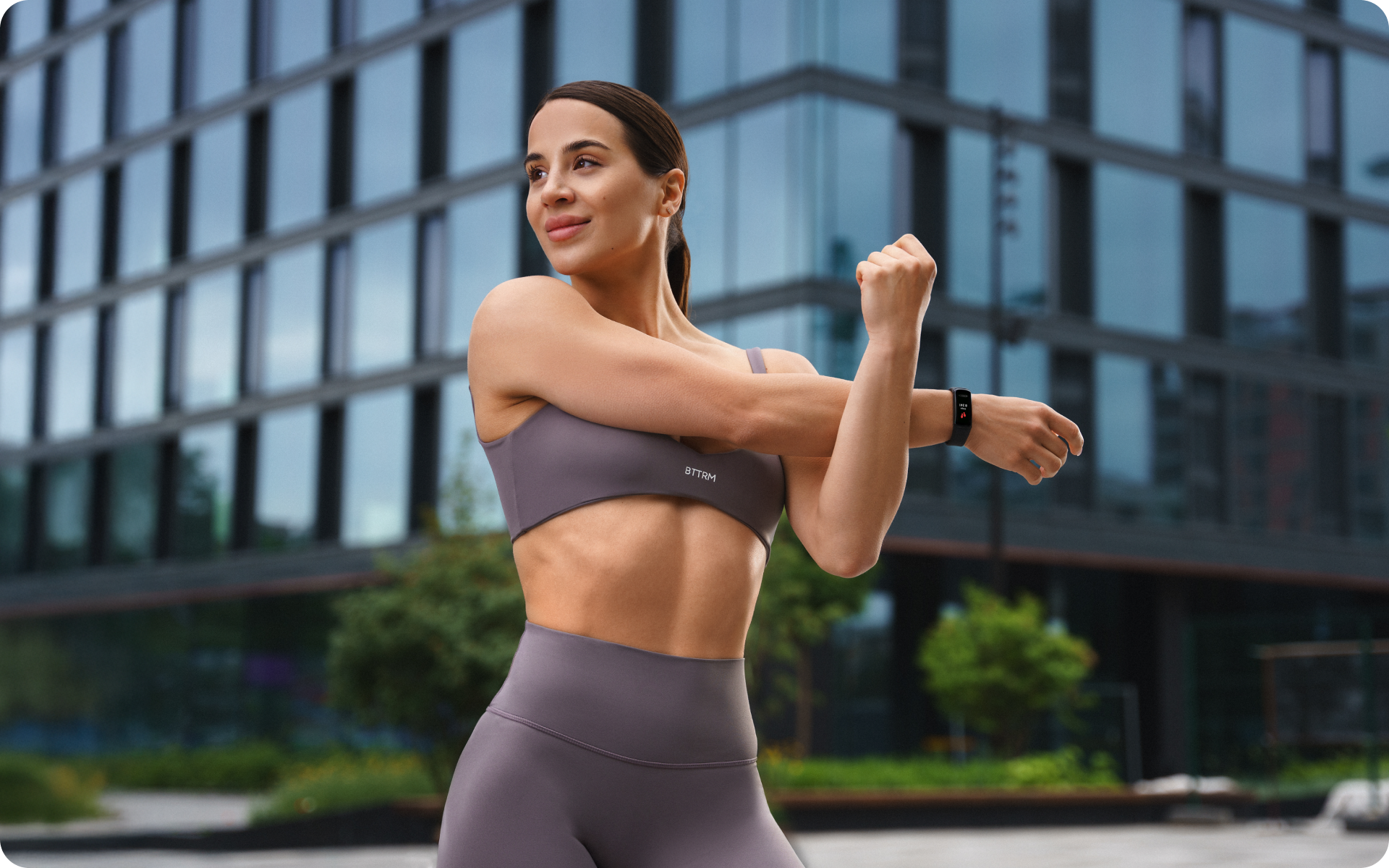Strong, functional legs are fundamental to nearly every aspect of movement. They power your athletic performance, from sprinting to jumping, while also laying the groundwork for everyday tasks such as walking and lifting (1).
Beyond raw strength, well-trained legs improve balance, stability, and joint integrity, which are essential for preventing injuries. They’re also key players in maintaining mobility as you age, ensuring you move efficiently and pain-free for years to come (2).
The best part? You don’t need fancy equipment to develop strong, explosive, and flexible legs. Calisthenics offers a range of exercises that harness your body weight to build strength and power.
Here are some of the top calisthenics leg exercises, and everything else you need to know.
What Are Some Leg Calisthenics Exercises?
1. Bodyweight Squats
One of the ultimate leg-building moves, the bodyweight squat targets your quads, hamstrings, glutes, and core.
How to do it:
- Stand with your feet shoulder-width apart and your toes slightly out.
- Lower your hips back and down, keeping your chest lifted and your knees tracking over your toes.
- Go as low as your mobility allows, then push through your heels to return to standing.
Benefits: Strengthens your legs and increases functional mobility in your hips, knees, and ankles.
Tip: To level up, add a pause at the bottom or perform tempo squats by slowing the descent.
2. Jump Squats
Add explosive power to your squat!
How to do it:
- Start in a squat position.
- Explode upward, driving through your toes and swinging your arms for momentum.
- Land softly with bent knees to protect your joints and repeat.
Benefits: Builds explosive strength and improves athletic performance.
Tip: Keep the landing quiet and controlled – this ensures proper form and joint safety.
3. Bulgarian Split Squats
This single-leg move is a game-changer for unilateral strength and stability.
How to do it:
- Place one foot on an elevated surface such as a bench or sturdy chair behind you.
- Lower into a lunge, keeping your front knee over the middle of your foot.
- Push through your front heel to return to standing.
Benefits: Strengthens quads, glutes, and balance. It can help fix muscular imbalances.
Tip: No bench? No problem! Stick to regular split squats (with your back foot on the ground) for similar benefits.
BetterMe: Health Coaching app helps you achieve your body goals with ease and efficiency by helping to choose proper meal plans and effective workouts. Start using our app and you will see good results in a short time.
4. Lateral Lunges
Engage your inner and outer thighs while enhancing mobility.
How to do it:
- From a standing position, step one foot out to the side.
- Shift your weight into that leg, bending the knee while keeping your other leg straight.
- Push back to the center using the foot that went out laterally and switch sides.
Benefits: Improves hip mobility and strengthens your adductors, glutes, and quads.
Tip: Keep your chest up and avoid rounding your back during side-to-side transitions.
5. Step-Ups
Develop single-leg power with this simple yet effective exercise.
How to do it:
- Find a sturdy elevated surface such as a step or box.
- Step up with one leg, pressing through your heel, then bring your other foot up. Step down, and repeat.
Benefits: Boosts strength and explosiveness. Also great for improving stability.
Tip: To make it harder, slow the movement down or add a knee drive with a pause at the top.
6. Pistol Squats (Single-Leg Squats)
The gold standard of calisthenics leg strength!
How to do it:
- Balance on one leg, extending the other straight out in front of you.
- Bend the knee of the leg that you are balancing on while simultaneously lowering your hips as if sitting down into a chair.
- Keep your straightened leg off the ground as you descend.
- Push back up on the bent leg while maintaining balance.
Benefits: Ultimate test of strength, control, and mobility. Works quads, glutes, hamstrings, and core.
Tip: Beginners can use a chair for support or perform assisted pistol squats by holding onto a wall or railing.
7. Broad Jumps
Unleash explosive power with this full-leg plyometric exercise.
How to do it:
- From a squat position, swing your arms back then forward as you jump forward as far as possible.
- Land softly, absorbing the impact through bent knees. Reset and repeat.
Benefits: Builds explosive power and develops fast-twitch muscle fibers.
Tip: Measure your jumps to track progress over time.
8. Wall Sits
Feel the burn with this isometric powerhouse.
How to do it:
- Stand with your back against a wall and slide down until your thighs are parallel to the ground.
- Hold this position for as long as possible with your core engaged.
Benefits: Strengthens endurance in the quads, glutes, and calves.
Tip: Try to maintain a squat position up against the wall with your knees at a 90-degree angle. Challenge yourself by holding a weight or lifting one leg for an extra burn.
9. Calf Raises
Don’t forget about those calves – they’re essential for power and stability.
How to do it:
- Stand with feet hip-width apart, then rise onto your toes.
- Lower down slowly and repeat.
Benefits: Strengthens calves, improves ankle mobility, and helps with jumping performance.
Tip: Try doing this on stairs for a greater range of motion.
10. Cossack Squats
A lateral squat with extra emphasis on flexibility.
How to do it:
- Stand wide with feet pointed slightly outward. Shift your weight to one leg, squatting down while keeping the other leg straight.
- Push back to center and alternate sides.
Benefits: Enhances hip and hamstring flexibility while building leg strength.
Tip: Go at your own pace and use support if you’re working on flexibility.
Explore more calisthenics workouts to help build leg strength in our guide to Bodyweight Lower Body Workout.
Read more: Women’s Calisthenics: The Strength Era Has Arrived
Can You Get Strong Legs Without Weights?
You can build strong legs without weights. Bodyweight training, or calisthenics, is a powerful and proven method for developing leg strength. It hinges on the scientific principles of muscle growth and adaptation, just like traditional weightlifting (3).
Here’s how it works:
- Muscle Adaptation to Resistance
Muscles don’t grow just because you lift heavy weights – they grow because they adapt to resistance. Your body treats its own weight as a form of resistance during exercises such as squats or lunges. If you work within a full range of motion and push your muscles close to fatigue, you stimulate growth. The key is continuous progression, consistency, and effort.
- Bodyweight Resistance Is Effective
Even without weights, your body can provide significant resistance. Exercises such as single-leg squats (pistol squats) or Bulgarian split squats make lifting your own body weight a tough challenge. These moves target your quads, glutes, hamstrings, and stabilizer muscles, all while improving balance and coordination.
Bodyweight movements also engage more muscles than machine-based exercises, which encourages full-body activation (3).
Tone your glutes, quads, and hamstrings with this resistance bands leg workout you can do from home or on the go.
- Progressive Overload Without Equipment
Progressive overload is essential for building strength. This is the gradual increase in demand placed on your muscles over time. With weights, you add more load (4). With calisthenics, you adjust other variables.
For example:
- Increase the number of repetitions or sets.
- Slow down your tempo for more time under tension.
- Advance to harder versions of the exercise, such as shifting from squats to jump squats.
Your muscles respond to these challenges in the same way they would in a gym.
- Functional Strength and Mobility
Training without weights emphasizes functional strength. This means your exercises mirror real-life movements, such as jumping or pushing off one leg to climb stairs. Over time, you improve not just strength but also mobility, coordination, and balance (5).
These benefits prevent injuries and enhance performance in sports and daily activities.
- Bodyweight Training Stimulates Multiple Muscle Groups
Many calisthenic exercises are compound movements. This means they work multiple muscle groups at once. For example, lunges train your quads, hamstrings, glutes, and calves. They also engage your core and spine for stability. This holistic training builds strength that’s both practical and efficient.
- Plyometrics for Explosiveness
Jump squats and broad jumps are forms of plyometric training. Plyometrics use explosive, forceful movements to develop power and fast-twitch muscle fibers. These fibers are the ones that are responsible for athletic explosiveness and strength in short bursts (6).
You don’t need weights to jump high or far – just effort and proper technique.
- Endurance Builds Strength Too
Bodyweight training often increases muscular endurance as you tend to do higher reps. While endurance may seem different from raw strength, they’re connected. A strong muscle is also an enduring one that is capable of handling resistance over time.
Read more: 13 Home Leg Workouts: Your Body is Your Main Equipment
What Is the Hardest Calisthenics Leg Exercise?
Defining the “hardest” calisthenics leg exercise isn’t straightforward as difficulty is relative. What feels impossible to one person may be manageable to another, depending on factors such as strength, mobility, balance, and experience. Some maneuvers challenge your muscles directly, while others demand precise control or explosiveness, which makes their difficulty highly subjective.
Here are a few examples of challenging leg exercises and why they test your limits:
1. Pistol Squats
The pistol squat – essentially a deep single-leg squat – is often considered one of the toughest bodyweight leg exercises. It demands impressive strength in your quads, glutes, and hamstrings while requiring tremendous balance and flexibility.
The real challenge comes from controlling your descent and keeping your extended leg aligned without tipping forward. For beginners, limited ankle mobility or hip strength can make this feel nearly impossible.
2. Shrimp Squats
Shrimp squats are another advanced single-leg exercise. Here, you bend one leg backward, gripping your foot with your hand while lowering yourself into a squat on the other leg. It’s brutal on your quads and demands extreme knee and hip mobility.
The bent-leg position places your body in a less stable position, which increases the difficulty of maintaining balance throughout the movement.
3. Explosive Plyometric Moves
Exercises such as jump squats, box jumps, or broad jumps bring their own level of difficulty. These moves require maximum power from your leg muscles, activating fast-twitch muscle fibers for explosive effort.
The difficulty lies in generating enough force to jump high or far while maintaining clean form. These exercises tire your legs quickly due to their high-intensity nature, which makes them a mental and physical challenge.
4. Harop Curls
The Harop curl is a hamstring-focused bodyweight movement that tests strength and control. It involves lowering your torso forward from a kneeling position, supported only by your hamstrings.
This eccentric-focused exercise is brutally challenging for most people as the hamstrings aren’t typically trained to control movements this precise.
Check out our blog post – Best Leg Exercises – and explore more challenging and well-structured exercises to help bulk your legs and build lower leg strength.
How Often Should I Train Legs with Calisthenics?
The frequency of leg training will depend on your goals and fitness level. Whether you’re aiming for strength, endurance, or mobility, your plan needs to reflect these objectives while allowing for recovery and progress.
Training for Overall Fitness
If your desire is to improve your overall fitness levels, 2-3 sessions per week is a solid approach. Overall fitness will combine strength, power, hypertrophy, mobility, and endurance training. This type of routine typically involves a number of different exercises. These can range from more intense exercises such as pistol squats, Bulgarian split squats, or even explosive moves such as a jump squat. These exercises place significant stress on your muscles, requiring 48-72 hours of recovery between sessions.
Recovery is essential because your muscles grow stronger during rest, not during the workout itself (7). Overtraining can lead to fatigue, reduced performance, and injury (8). Stick to quality over quantity – focus on perfect form and controlled reps.
When it comes to weight loss, progress is made by inches, not miles, so it’s much harder to track and a lot easier to give up. The BetterMe: Health Coaching app is your personal trainer, nutritionist, and support system all in one. Start using our app to stay on track and hold yourself accountable!
Training for Endurance
To improve muscular endurance, you can train your legs more frequently. Aim for 3-4 sessions per week, using higher-rep, moderate-intensity exercises such as bodyweight squats, lunges, or step-ups. Unlike strength training, endurance work involves less muscle damage, so your recovery time is shorter (9).
However, balance is key. While you can handle a higher volume, make sure to rotate the intensity. Light, moderate, and higher-intensity days ensure you don’t overburden your body.
Training for Mobility
Mobility training for your legs often focuses on smaller movements and dynamic stretches. This can be done almost daily, as it’s less taxing on your muscles. Movements such as Cossack squats, dynamic lunges, and deep squat holds improve your range of motion and joint health.
As mobility work is low-impact, it doubles as recovery on rest days. Incorporating it daily can improve flexibility and prevent stiffness, which supports long-term progress in both strength and endurance.
Combining Goals
If you’re juggling multiple goals, combine them strategically. For example, aim for 2 strength sessions, 1-2 endurance-focused workouts, and daily mobility training. Adjust as necessary, based on how your body responds.
Listen to Your Body
Regardless of your goals, you should pay attention to your body’s signals. If you feel unusually sore, fatigued, or lack energy, take an extra rest day. Consistency is important, but overdoing it can backfire.
No, true calisthenics practitioners don’t skip leg day. While upper-body moves such as pull-ups and push-ups often steal the spotlight, leg exercises are equally important in a balanced calisthenics routine. Bodyweight leg exercises such as squats, lunges, and pistol squats build strength, endurance, and mobility. In addition, plyometric movements, such as jump squats and broad jumps, develop explosive power and athleticism. Efficient calisthenics training always incorporates legs to ensure functional, full-body strength (3). Having strong but not muscular legs often comes down to the type of training you’re doing and how low your body fat percentage is. Strength can build without significant muscle size, particularly if you focus on low-rep, high-effort work. This type of training improves neural efficiency, which means your body gets better at recruiting existing muscle fibers without necessarily adding mass (10). On the other hand, muscle growth (hypertrophy) usually requires higher reps, sufficient volume, and a caloric surplus (11, 12). Genetics also play a role in how your muscles respond to training, so you may naturally gain strength faster than size. Working on lowering your body fat percentage can result in muscular definition. Yes, skinny legs can absolutely be strong. Muscle size and strength are related but not the same. Strength relies on your body’s ability to recruit muscle fibers efficiently, which doesn’t always lead to noticeable size increases (13). Competitive endurance athletes often have lean but very strong legs due to their focus on function rather than hypertrophy. Factors such as muscle density, tendon health, and training style all contribute to strength, regardless of visible muscle size. To bulk your legs, focus on hypertrophy training. This involves moderate-to-high reps (8-12), multiple sets, and progressive overload – gradually increasing the difficulty. Bodyweight exercises such as Bulgarian split squats, shrimp squats, or step-ups with extra reps or a weighted vest can contribute to size. Proper nutrition is also essential. Eat in a caloric surplus, prioritizing protein to support muscle repair and growth (12). Supplement your training with mobility work to ensure your joints can handle added muscle mass and make sure you get adequate rest to allow recovery.Frequently Asked Questions
Does calisthenics skip leg day?
Why are my legs strong but not muscular?
Can skinny legs still be strong?
How can I bulk my legs?
The Bottom Line
Leg calisthenics exercises offer a flexible, effective way to build strength, improve mobility, and boost functional fitness. They require no equipment and challenge your body in unique and powerful ways. From explosive plyometrics to controlled single-leg movements, these exercises cater to all fitness levels, which promotes balanced lower-body development. Commit to consistency, proper form, and progressive overload and you’ll unlock the full potential of your legs.
DISCLAIMER:
This article is intended for general informational purposes only and does not serve to address individual circumstances. It is not a substitute for professional advice or help and should not be relied on for making any kind of decision-making. Any action taken as a direct or indirect result of the information in this article is entirely at your own risk and is your sole responsibility.
BetterMe, its content staff, and its medical advisors accept no responsibility for inaccuracies, errors, misstatements, inconsistencies, or omissions and specifically disclaim any liability, loss or risk, personal, professional or otherwise, which may be incurred as a consequence, directly or indirectly, of the use and/or application of any content.
You should always seek the advice of your physician or other qualified health provider with any questions you may have regarding a medical condition or your specific situation. Never disregard professional medical advice or delay seeking it because of BetterMe content. If you suspect or think you may have a medical emergency, call your doctor.
SOURCES:
- Strong legs help power summer activities: Hiking, biking, swimming, and more (2024, health.harvard.edu)
- The Effects of Physical Exercise on Balance and Prevention of Falls in Older People: A Systematic Review and Meta-Analysis (2020, ncbi.nlm.nih.gov)
- Bodyweight Training: A Return To Basics (2010, journals.lww.com)
- Progressive Overload Explained: Grow Muscle & Strength Today (n.d., blog.nasm.org)
- The advantages of body-weight exercise (2024, health.harvard.edu)
- CURRENT CONCEPTS OF PLYOMETRIC EXERCISE (2015, ncbi.nlm.nih.gov)
- Exploring the Science of Muscle Recovery (n.d., blog.nasm.org)
- Overtraining Syndrome as a Complex Systems Phenomenon (2022, frontiersin.org)
- Adaptations to Endurance and Strength Training (2018, ncbi.nlm.nih.gov)
- Loading Recommendations for Muscle Strength, Hypertrophy, and Local Endurance: A Re-Examination of the Repetition Continuum (2021, ncbi.nlm.nih.gov)
- The Mechanisms of Muscle Hypertrophy and Their Application to Resistance Training (2010, journals.lww.com)
- Is an Energy Surplus Required to Maximize Skeletal Muscle Hypertrophy Associated With Resistance Training (2019, ncbi.nlm.nih.gov)
- Muscle hypertrophy and muscle strength: dependent or independent variables? A provocative review (2020, ncbi.nlm.nih.gov)
